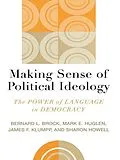Political positions in the United States today are ideologically chaotic, and there are significant prices to pay for that chaos. The nation has not reached a crisis yet in her modern political gridlock, but predicting the time when the current generation will face the difficulties of earlier times of crisis such as the Civil War, the Great Depression, or World War II is a difficult task. When that time comes, leaders who can communicate effectively to foster understanding and political unity_and who can respond to a crisis with skilled direction_will be a vital concern. Making Sense of Political Ideology explores the erosion of ties among ideology, language, and political action. Analyzing political language strategies, it shows how to dissect language so we can better understand a speaker's ideology. The authors define four political positions_radical, liberal, conservative, reactionary_and apply their techniques to contemporary issues such as the war on terrorism. They emphasize the dangers of staying trapped in political gridlock with no consensus for governmental direction and propose that the ability to identify and bridge positions can help political communicators toward constructing coalitions and building support for political action.
Autorentext
By Bernard L. Brock; Mark E. Huglen; James F. Klumpp and Sharon Howell
Inhalt
Chapter 1 Preface
Chapter 2 1 Ideological Chaos and Political Gridlock: Political Communication in the Early Twenty-first Century
Chapter 3 2 Political Ideology and Democracy
Chapter 4 3 Political Positions and American Politics
Chapter 5 4 Rhetorical Strategies and the Four Political Positions
Chapter 6 5 Beyond the Political Chaos: Where Are We Going?
Chapter 7 Bibliography
